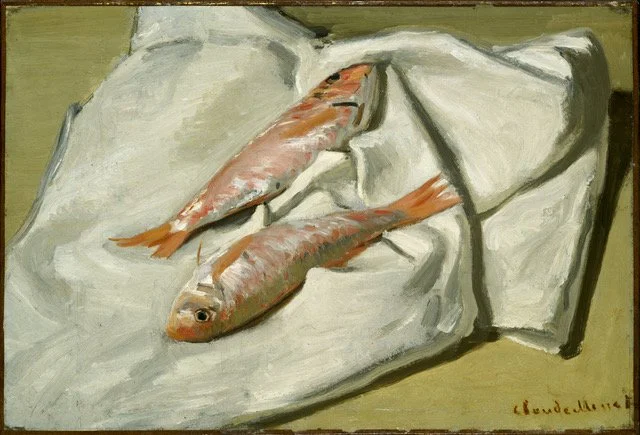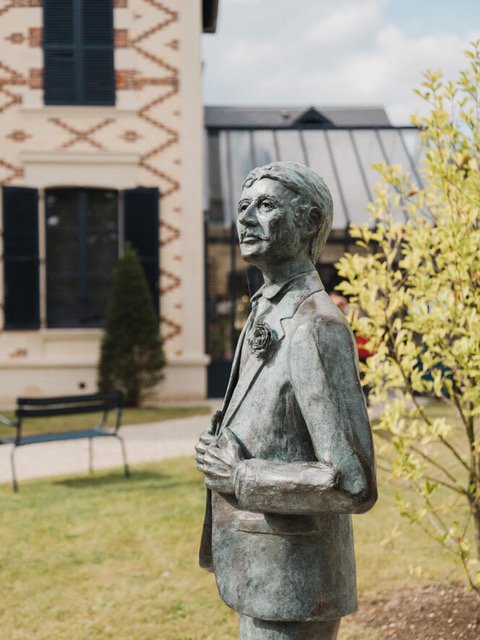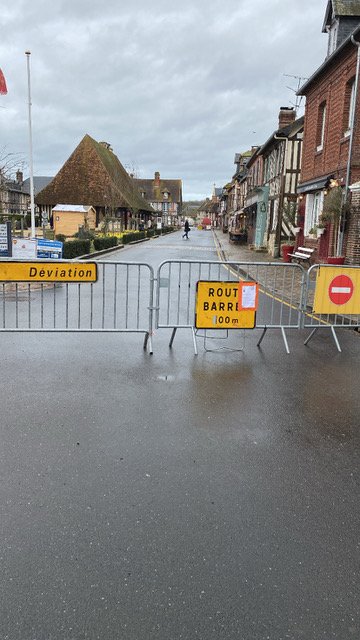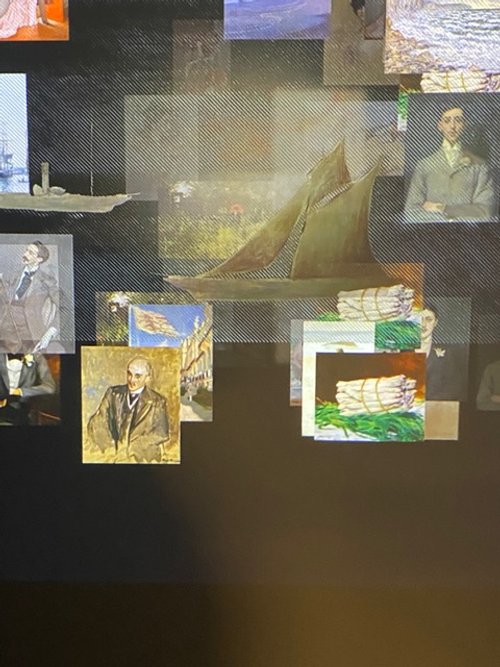In the footsteps of two nattily dressed guys: Marcel Proust and David Hockney
Road trip! When a friend asked if I wanted to go to Cabourg, I muffled a scream and shouted YES, YES, YES!!! Cabourg, as many of you know, is the seaside village in Normandy that Proust calls Balbec. You can read some of the loveliest descriptions of the sky and the sea and the girls on bicycles in Volume II of A la recherche du temps perdu: A l’ombre des jeunes filles en fleur, which takes place there. (Fig 1)
Figure 1. Cabourg at night, February 13, 2024
There was no question about where to stay. The Grand Hotel, of course! That’s where Proust stayed from late summer every summer to early fall every fall, from 1907-1914. He would have continued going to Cabourg and to the Grand Hotel. (Fig 2) But the Great War intervened and the hotel was requisitioned by the army and transformed into a hospital for wounded soldiers. The Grand Hotel actually replaced an earlier hotel, called the Hotel de la Plage. That’s where Proust’s narrator stayed with his grandmother in Volume II. And where Proust stayed in September of 1900.
Figure 2. Grand Hotel, Cabourg
Figure 2a. Me in front of Grand Hotel, Cabourg
I have read Proust's detailed descriptions of the Grand Hôtel, its corridors, its dining room, the esplanade that runs in front of it, along the beach, which is now the Promenade Marcel Proust. The Hôtel has remained virtually unchanged since Proust’s time and because of Proust, it is now a registered historic monument. Indeed, the hotel is one of the best preserved examples of Belle Époque architecture in France and the Promenade Marcel Proust is the longest such esplanade in Europe.
Cabourg has been a seaside resort since the 1860s, along with nearby Deauville and neighboring Trouville. All were developed to welcome wealthy Parisians fleeing the heat of Paris summers. We’ve all heard of Deauville, the American Film Festival is held there. Deauville is more elegant than Cabourg, more stately than Trouville. I’ve been to Deauville a few times, staying once at the luxurious Barrière Hotel in town and once at the equally grand Barrière Hotel du Golf, which is not exactly in town, but which is exactly on a golf course. When we stayed in town, we took a little boat over to Trouville for a copious plate of moules frites at one of the many casual seaside bistros. I chose well - Jean Dujardin was at the next table!
My French friend kept referring to the body of water on which these seaside villages sit as La Manche, (sleeve). That’s what the French have called it since at least the 17th century. We call it the English Channel. Whether it’s a channel, a sleeve, or an arm (Wikipedia), it separates Southern England from Northern France (Normandy) and connects the Atlantic Ocean to the southern part of the North Sea. And it’s an easy trip, whether by train or car, from Paris, probably its most important recommendation.
The times I visited Deauville, there were so many places I wanted to see en route - Rouen for its cathedral, Bayeux for its tapestry, Honfleur for its connection to Impressionism and Lisieux, the second most visited pilgrimage site in France
This time, I didn’t want to stop anywhere en route. I wanted to get to Cabourg and immerse myself in its Proustness. And I wanted to enjoy the luxurious Grand Hotel. It’s a 5 star hotel, so off season was the only season I could afford to stay there.
We set off at 9:00 a.m. for our two hour journey by car from Paris. Although check-in was at 4:00 p.m., I wanted to arrive early and try to visit Room 414, the room where Proust stayed. I figured that even if someone had booked it for the night, I could see it before they checked in. In the event, nobody had. And a very charming member of staff accompanied me to Proust’s room where we talked Proust. (Figs 3, 4). He told me that Proust often booked the rooms on either side of him so that he wouldn’t be disturbed by other people in adjacent rooms. As he was on the top floor, he wasn’t bothered by noise from the room above, which was a problem for him in Paris.
Figure 3. Door to Room 414, Proust’s bedroom, Grand Hotel, Cabourg
Figure 4. Me in Proust’s bedroom, Grand Hotel, Cabourg
Figure 4a. Me and my guide in Proust’s bedroom, Grand Hotel, Cabourg
Since I had booked a room with the (cheaper) garden view, I knew I would not be able to lay on my bed, looking out my window watching the sky and the sea change as Proust described in his novel. But it really wasn’t much of an inconvenience to walk along the Promenade Marcel Proust in the morning, in the afternoon, in the evening, when it was raining, when it was cloudy, when the sun was shining. (Figs 5, 6) I reread passages in which Proust describes the sky, calling upon his visual memory to evoke Japanese prints and J.M.Whistler paintings and even meals he had been served! (Figs 7, 8, 9)
Figure 5. Walking along Promenade Marcel Proust, Cabourg
Figure 6. Me on the Promenade Marcel Proust as the sky begins to clear
Figure 7. Hiroshige, Japanese print referred to by Proust in his description of the sea at Balbec
Figure 8. James McNeil Whistler, Harmony in Pink & Grey (Proust referred to in his description of sea at Balbec)
Figure 8a. James McNeil Whistler, Harmony in Blue & Silver in nearby Trouville
Figure 9. Claude Monet, Red Mullets, to which Proust referred in a description of the sea at Cabourg
“Gradually, (Proust writes) as the season advanced, the picture that I found in my window changed. At first it was broad daylight, and dark only if the weather was bad: and then …the sea, set between the iron uprights of my casement window … travelled out over all the deep rocky border of the bay”. And this, “A few weeks later, when I went upstairs, the sun had already set. (A) band of red sky above the sea, compact and clear-cut as a layer of aspic over meat, then, a little later, over a sea already cold and blue like the fish called mullet, a sky of the same pink as…salmon…”
I also wanted to visit the new museum in Cabourg, the Villa du Temps Retrouvé. (Fig 10) It opened in 2021, the 150th anniversary of Proust’s birth. But it closes annually from November to March. When I mentioned that to Allan, a member of my Proust reading group at the American Library, he suggested that I contact the museum, tell them that I was a journalist and ask if I could visit the museum. Which I did, which I will tell you about in a minute.
Figure 10. Villa du Temp Retrouvé, Cabourg’s museum of the Belle Epoque
Figure 10a. Statue of Proust in museum garden
I also wanted to visit the church Proust waxes lyrical about. But I couldn’t track it down and only learned later (from the director of the museum) that Balbec is an amalgamation of three towns, Cabourg, Houlgate (where Proust’s grandmother lived) and Dives sur mer where the church Proust describes is located.
So I stumbled upon something else to do! Just by chance, I was leafing through my book of David Hockney’s paintings of Normandy, paintings which I saw at the Galerie Lelong in 2020. That was a between time during the pandemic, when museums were closed but art galleries were open. The village closest to Hockney’s own home is Beuvron en Auge. Cabourg is only 15 km from Beuvron. It’s only a 20 minute drive.
Day 2 of my three days in Cabourg came into focus. As it turns out, it was Valentine’s Day and impossible to reserve dinner in Cabourg anywhere that didn’t insist upon the ‘Valentine’s Day Menu’. Which at the Grand Hotel was 175€/person. I found a restaurant in Beuvron for lunch. I figured we could have a nice lunch and skip dinner. After an early morning stroll in Cabourg, we drove to Beuvron. The main road (only road?) into town was being resurfaced so we parked in a large open space and risked life and limb walking between the fork lifts and cement trucks (Fig 11) to the center square which had so captivated me when I first saw Hockney’s paintings of it.
Figure 11. Route Barrée to main road into Beuvron en Auge
I had seen photos of the paintings before going to the gallery in 2020, so I had dressed in my colombage best, aka vertical and horizontal stripes. Red, of course. When I got to the gallery, I was sorely disappointed because: Photos Interdites! This time would be different, I packed my colombage outfit in Paris and wore it in Beuvron. To be photographed in front of the real buildings, not David Hockney’s paintings of them. It wasn’t exactly what I imagined because, well, red. (Figs 12, 13, 14)
Figure 12. Me in Beuvron en Auge
Figure 13. Me in Beuvron en Auge
Figure 14. David Hockney with his painting of Village Square of Beuvron en Auge
Figure 14a. Me with Hockney's painting of Village Square of Beuvron en Auge
Par hazard we had reserved lunch in what had been the old Market of Beuvron, the centerpiece of Hockney’s paintings! There is no a la carte dining, the options are two courses for 59€, three courses for 67€, and so on. We initially thought that 2 courses would be enough. But hey, for only 8€ more, why be frugal. The 25 ml pitcher of wine we ordered for 10€ wasn’t brought to the table filled from a box of wine or the dregs of mostly empty bottles in the kitchen. No indeed! The server came to our table with a pitcher and a newly opened bottle of wine and poured it to the very top.
In this little village, a young chef (27 years old) is creating exceptional meals. A sense of inventiveness and generosity informed every part of our three hour adventure! There were two amuse bouches. The first, three elegant squares, each subtly different, each sitting atop a paper thin biscuit. The second Amuse Bouche was a square of sausage enrobed in a frothy savory mousse. The server had placed an individual loaf of dark bread on the table. (Figs 15, 16, 17) When I remarked that the bread was a perfect accompaniment to the amuse bouches, she told me, with considerable pride, that everything served at the restaurant, except the butter, was made there!
Figure 15. Amuse Bouche 1, Pavé d’Auge Restaurant, Beuvron en Auge
Figure 16. Amuse Bouche, Pavé d’Auge in Beuvron en Auge
Figure 17. Bread and Butter at Pavé d’Auge in Beuvron en Auge
My favorite restaurant in the Dordogne is like this. A chef creates marvels for discerning diners in a small village restaurant. The quality of food and presentation at Pavé d’Auge in Beuvron and Le Vieux Logis in Tremolat would cost hundreds of euros in Paris, many more dollars in San Francisco.
For my entrée, I chose ‘Foie gras de la Ferme de la Houssaye poêlé, cacao and topinambours’ (Fig 18) I learned about pan fried foie gras in one of Peter Mayle’s first books. His man servant prepared it for him in London, before he moved to Provence. It’s a lesson in foie gras preparation, because, we are told, if the foie sits in the pan, on the heat, for too long, it will simply melt away.
Figure 18. Foie gras poêlé, Pavé d’Auge, Beuvron en Auge
I am not going to apologize for loving foie gras. There is a big difference between artisanal sources and industrial ones. At this restaurant, we learn the foie’s provenance. It reminded me of a sketch in the series Portlandia, when the two main characters are in a restaurant talking with the server about the chicken they are ordering. Was it happy, did it have friends. My foie gras was tender and delicate. I ate it slowly, savoring each well seasoned (cacao) morsel and each paper thin slice of Jerusalem artichoke.
My main was described this way: Bar cuit au beurre parfumé à la main de bouddha, haricots blancs déclinés et choux blanc. (Fig 19) Translated that’s thin slices of sea bass under which was nestled a stew of melted cabbage and white beans.
Figure 19. My main dish, (sea bass) the pale colors made festive with intricate edible pattern on top
It’s a good thing that the plates are brought out slowly. The portions are small in size but big in flavor. After the server asked if we had changed our mind about a cheese course (we just couldn’t), he swept away the bread crumbs and brought us a pre-dessert! (Fig 20) An airy mousse with slices of dried kumquats on top!
Figure 20. Like a palate cleanser to get us from savory to sweet
Then, finally, dessert. Since this part of Normandy is Calvados country, I chose a ‘Soufflé chaud au Calvados et soufflé glacé aux baies de genièvre.’ (Fig 21) Two ramekins came to the table. The larger one was a perfectly puffed hot soufflé decadently redolent of calvados. The soufflé glacé, like a scoop of the creamiest ice cream you have ever tasted, was scented with juniper berries. I am particularly fond of juniper berries, not because I like gin but because there is a juniper bush behind Leonardo de Vinci’s portrait of Ginevra de Benci, (Fig 22) my daughter’s namesake!
Figure 21. Large hot calvados soufflé, tiny gin flavored soufflé glacé
Figure 22. Ginevra de Benci, a juniper berry bush behind her, Leonardo de Vinci (Nat’l Gal, Wash, D.C.)
It was difficult to leave Beuvron en Auge, but I had an appointment! With the Director of the Villa du temps retrouvé, the new museum in Cabourg and the Press Relations Manager of Cabourg, who had set up the meeting. We talked about the concept of the museum in a town so closely associated with Proust. Yes, the museum opened on the 150th anniversary of Proust’s birth, but rather than an homage to Proust, it is a celebration of the Belle Epoque. According to the museum’s website, the purpose of the museum is for visitors “to better understand this time suspended between two centuries, between two wars, between two worlds, a time already modern but not yet contemporary, which had Paris as the center of the world in winter, and seaside resorts including those of the Côte Fleurie (the Normandy coast), in summer.”
Since the museum was closed (open March through November) I could only visit a few of the immersive rooms. In one, all the paintings that I had seen in the original, at the Parisian Proust exhibitions in 2021/2022, were on a constant circuit. Manet’s Asparagus, of course and Boldini’s portrait of Robert Montesquiou; the young women in the Botticelli painting at the Louvre and Jacques-Emile Blanche’s portrait of Proust.(Figs 23 - 26) In another room, it’s moving pictures. The action begins in Paris where society people swan about, woman in opulent gowns, men in top hats and tails, carriages taking them from one soirée to another. Next, these same people are shown getting onto a train. The final scene is in Cabourg where they have reassembled and are promenading along the beach. Striped beach cabins remind one of Daniel Buren (Figs 27-29) In other rooms, there is a mix of art and technology that will keep young visitors amused and more sophisticated ones, engaged. (Figs 30, 31).
Figure 23. The moving slide show of Proust / Belle Époque greatest hits, 1
Figure 24. The moving slide show of Proust / Belle Époque greatest hits, 2
Figure 25. Robert Montesquiou by Giovanni Boldini (Proust’s Baron de Charlus)
Figure 26. Portrait of Marcel Proust by Jacques-Emile Blanche
Figure 26a. Photo of portrait of Proust hangs everywhere at the Grand Hotel, this one, in the lobby with his signature and dates he stayed at Grand Hotel, bottom right
Figure 27. Camille on the beach at Trouville, Claude Monet
Figure 28. Beach at Cabourg, 1910, René-Xavier Prinet
Figure 29. Contemporary Cabourg Beach in season
Figure 30. Moving photos in frames
Figure 31. Music & Dance
Here’s a fun fact. Cabourg has its own film festival - for romantic films! So, of course Valentine’s Day is celebrated in Cabourg. The day ended with fireworks on the beach, right outside our hotel. What a treat (Figs. 32, 33)
Figure 32. Valentine’s Day Decorations in Garden in front of Grand Hotel, Cabourg
Figure. 33. Fireworks in Cabourg, February 14, 2024
With a car, you can make Cabourg a day trip, but why not make it a weekend. Stay in Cabourg and make sure to visit the Villa du Temps Perdu. If you are a Proustian, make your way over to Houlgate and Dives sur mer. If you are a Hockneyite, take a quick drive over to Beuvron en Auge. If you have time, you couldn’t spend it better than enjoying a relaxing meal at Pavé d’Auge in Beuvron. If you just want to experience more of the Cote Fleurie, Deauville is a must. En route from Paris, you have so many choices - Rouen, Honfleur, Bayeux. Bon route! Gros Bisous, Dr. B.
Copyright © 2024 Beverly Held, Ph.D. All rights reserved
Dear Reader, I hope you enjoyed reading this article. Please sign up below to receive more articles plus other original content from me, Dr. B. Merci!
And, if you enjoyed reading this review, please consider writing a comment. Thank you!









































